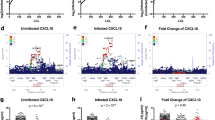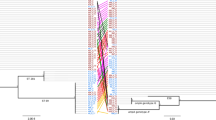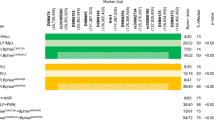Abstract
Chlamydia trachomatis is a bacterial pathogen that is a major cause of blindness and infertility in diverse populations across the world. In an effort to model genetic complexities that are observed in human populations and to identify novel genes involved in susceptibility to C. trachomatis, we have adapted a murine model of systemic infection for use in genetic analysis. In this model, chlamydial colonization and replication is measured in the spleens of mice shortly after intravenous delivery of C. trachomatis L2. Here, we show that C57BL/6J and C3H/HeJ inbred mice are differentially susceptible to this systemic infection. Additionally, fibroblasts cultured from C57BL/6J and C3H/HeJ embryos are differentially permissive for chlamydial replication. We have taken advantage of this natural variation to map quantitative trait loci on Chromosomes 2, 3, and 11 that segregate with the bacterial load in F2 cross progeny during the acute phase of C. trachomatis infection in vivo. To validate our mapping results, we also generated mice that are congenic for a portion of Chromosome 11 from the susceptible parent. This congenic interval confers increased susceptibility to C. trachomatis, both in vivo and in vitro, suggesting that our screen identified at least one gene that is involved in cellular resistance to C. trachomatis replication.
This is a preview of subscription content, access via your institution
Access options
Subscribe to this journal
Receive 6 digital issues and online access to articles
$119.00 per year
only $19.83 per issue
Buy this article
- Purchase on Springer Link
- Instant access to full article PDF
Prices may be subject to local taxes which are calculated during checkout





Similar content being viewed by others
References
Schachter J . Infection and disease epidemiology. In: Stephens RS (ed). Chlamydia: Intracellular Biology, Pathogenesis, and Immunity. ASM Press: Washington DC, 1999, pp 139–169.
Hackstadt T . Cell biology. In: Stephens RS (ed). Chlamydia: Intracellular Biology, Pathogenesis, and Immunity. ASM Press: Washington DC, 1999, pp 101–138.
Brunham RC . Human immunity to chlamydiae. In: Stephens RS (ed) Chlamydia: Intracellular Biology, Pathogenesis, and Immunity. ASM Press: Washington DC, 1999, pp 211–238.
Witkin SS, Linhares I, Giraldo P, Jeremias J, Ledger WJ . Individual immunity and susceptibility to female genital tract infection. Am J Obstet Gynecol 2000; 183: 252–256.
Kimani J, Maclean IW, Bwayo JJ, MacDonald K, Oyugi J, Maitha GM et al. Risk factors for Chlamydia trachomatis pelvic inflammatory disease among sex workers in Nairobi, Kenya. J Infect Dis 1996; 173: 1437–1444.
Cohen CR, Gichui J, Rukaria R, Sinei SS, Gaur LK, Brunham RC . Immunogenetic correlates for Chlamydia trachomatis-associated tubal infertility. Obstet Gynecol 2003; 101: 438–444.
Geisler WM, Tang J, Wang C, Wilson CM, Kaslow RA . Epidemiological and genetic correlates of incident Chlamydia trachomatis infection in North American adolescents. J Infect Dis 2004; 190: 1723–1729.
Wang C, Tang J, Geisler WM, Crowley-Nowick PA, Wilson CM, Kaslow RA . Human leukocyte antigen and cytokine gene variants as predictors of recurrent Chlamydia trachomatis infection in high-risk adolescents. J Infect Dis 2005; 191: 1084–1092.
Conway DJ, Holland MJ, Bailey RL, Campbell AE, Mahdi OS, Jennings R et al. Scarring trachoma is associated with polymorphism in the tumor necrosis factor alpha (TNF-alpha) gene promoter and with elevated TNF-alpha levels in tear fluid. Infect Immun 1997; 65: 1003–1006.
Rupp J, Goepel W, Kramme E, Jahn J, Solbach W, Maass M . CD14 promoter polymorphism -159C>T is associated with susceptibility to chronic Chlamydia pneumoniae infection in peripheral blood monocytes. Genes Immun 2004; 5: 435–438.
Qiu H, Yang J, Bai H, Fan Y, Wang S, Han X et al. Less inhibition of interferon-gamma to organism growth in host cells may contribute to the high susceptibility of C3H mice to Chlamydia trachomatis lung infection. Immunol 2004; 111: 453–461.
Tuffrey M, Falder P, Gale J, Quinn R, Taylor-Robinson D . Infertility in mice infected genitally with a human strain of Chlamydia trachomatis. J Reprod Fert 1986; 78: 251–260.
Tuffrey M, Alexander F, Woods C, Taylor-Robinson D . Genetic susceptibility to chlamydial salpingitis and subsequent infertility in mice. J Reprod Fert 1992; 95: 31–38.
de la Maza LM, Pal S, Khamesipour A, Peterson EM . Intravaginal inoculation of mice with the Chlamydia trachomatis mouse pneumonitis biovar results in infertility. Infect Immun 1994; 62: 4675–4681.
Darville T, Andrews Jr CW, Laffoon KK, Shymasani W, Kishen LR, Rank RG . Mouse strain-dependent variation in the course and outcome of chlamydial genital tract infection is associated with differences in host response. Infect Immun 1997; 65: 3065–3073.
Darville T, Andrews Jr CW, Sikes JD, Fraley PL, Rank RG . Early local cytokine profiles in strains of mice with different outcomes from chlamydial genital tract infection. Infect Immun 2001; 69: 3556–3561.
Darville T, Andrews Jr CW, Sikes JD, Fraley PL, Braswell L, Rank RG . Mouse strain-dependent chemokine regulation of the genital tract T helper cell type 1 immune response. Infect Immun 2001; 69: 7419–7424.
Rottenberg ME, Gigliotti-Rothfuchs A, Wigzell H . The role of IFN-gamma in the outcome of chlamydial infection. Curr Opin Immunol 2002; 14: 444–451.
Buzoni-Gatel D, Bernard F, Pla M, Rodolakis A, Lantier F . Role of H-2 and non-H-2-related genes in mouse susceptibility to Chlamydia psittaci. Microb Pathog 1994; 16: 229–233.
Dietrich WF . Using mouse genetics to understand infectious disease pathogenesis. Genome Res 2001; 11: 325–331.
Buer J, Balling R . Mice, microbes and models of infection. Nat Rev Genet 2003; 4: 195–205.
Brunham RC, Kuo C, Chen WJ . Systemic Chlamydia trachomatis infection in mice: a comparison of lymphogranuloma venereum and trachoma biovars. Infect Immun 1985; 48: 78–82.
Manly KF, Cudmore Jr RH, Meer JM . Map Manager QTX, cross-platform software for genetic mapping. Mamm Genome 2001; 12: 930–932.
Ott J . Analysis of Human Genetic Linkage. The Johns Hopkins University Press: Baltimore & London, 1991, pp 66–67.
Lander E, Kruglyak L . Genetic dissection of complex traits: guidelines for interpreting and reporting linkage results. Nat Genet 1995; 11: 241–247.
Nelson DE, Virok DP, Wood H, Roshick C, Johnson RM, Whitmire WM et al. Chlamydial IFN-gamma immune evasion is linked to host infection tropism. Proc Natl Acad Sci USA 2005; 102: 10658–10663.
Flint J, Valdar W, Mott R . Strategies for mapping and cloning quantitative trait genes in rodents. Nat Rev Genet 2005; 6: 271–286.
Howard L, Orenstein NS, King NW . Purification on renografin density gradients of Chlamydia trachomatis grown in the yolk sac of eggs. Appl Microbiol 1974; 27: 102–106.
Steele LN, Balsara ZR, Starnbach MN . Hematopoietic cells are required to initiate a Chlamydia trachomatis-specific CD8+ T cell response. J Immunol 2004; 173: 6327–6337.
Acknowledgements
We thank Nathan Billings, James Nicholas Lafave, David Regan, and Tao Zou for technical support. Thanks also to Russell Vance for critical reading of the manuscript. This work was supported by an Investigator grant to WFD by Howard Hughes Medical Institute, and by National Institutes of Health Grants AI039558 and AI055900 to MNS. JC was supported by a research fellowship from the Deutsche Forschungsgemeinschaft. IBH was supported by a predoctoral research fellowship from the National Science Foundation.
Author information
Authors and Affiliations
Corresponding author
Rights and permissions
About this article
Cite this article
Bernstein-Hanley, I., Balsara, Z., Ulmer, W. et al. Genetic analysis of susceptibility to Chlamydia trachomatis in mouse. Genes Immun 7, 122–129 (2006). https://doi.org/10.1038/sj.gene.6364285
Received:
Revised:
Accepted:
Published:
Issue Date:
DOI: https://doi.org/10.1038/sj.gene.6364285
Keywords
This article is cited by
-
Dendritic cell function and pathogen-specific T cell immunity are inhibited in mice administered levonorgestrel prior to intranasal Chlamydia trachomatis infection
Scientific Reports (2016)
-
CXCR3 and CCR5 are both required for T cell-mediated protection against C. trachomatis infection in the murine genital mucosa
Mucosal Immunology (2011)
-
Genetic control of susceptibility to pulmonary infection with Chlamydia pneumoniae in the mouse
Genes & Immunity (2008)
-
Genetics-squared: combining host and pathogen genetics in the analysis of innate immunity and bacterial virulence
Immunogenetics (2007)



